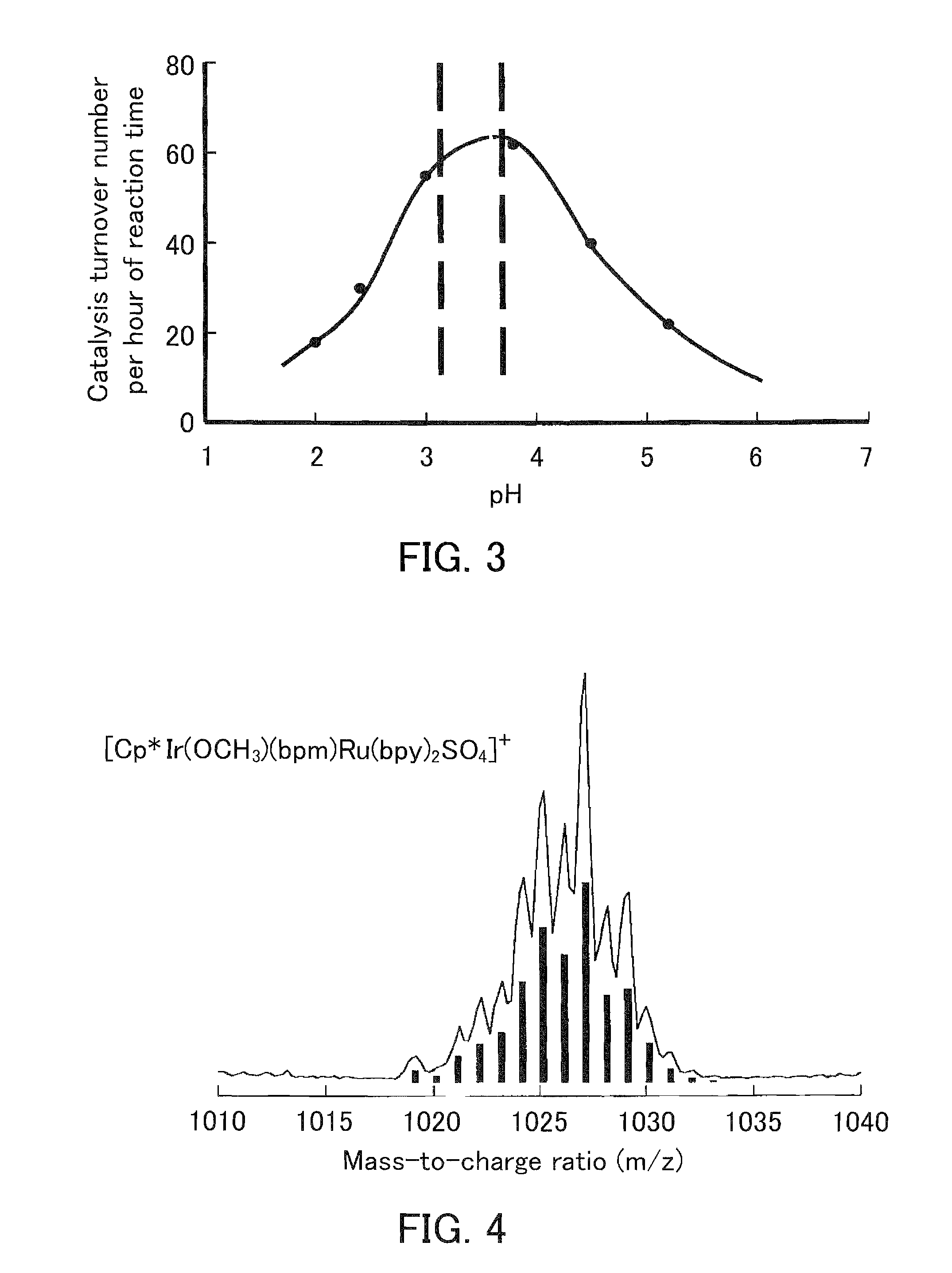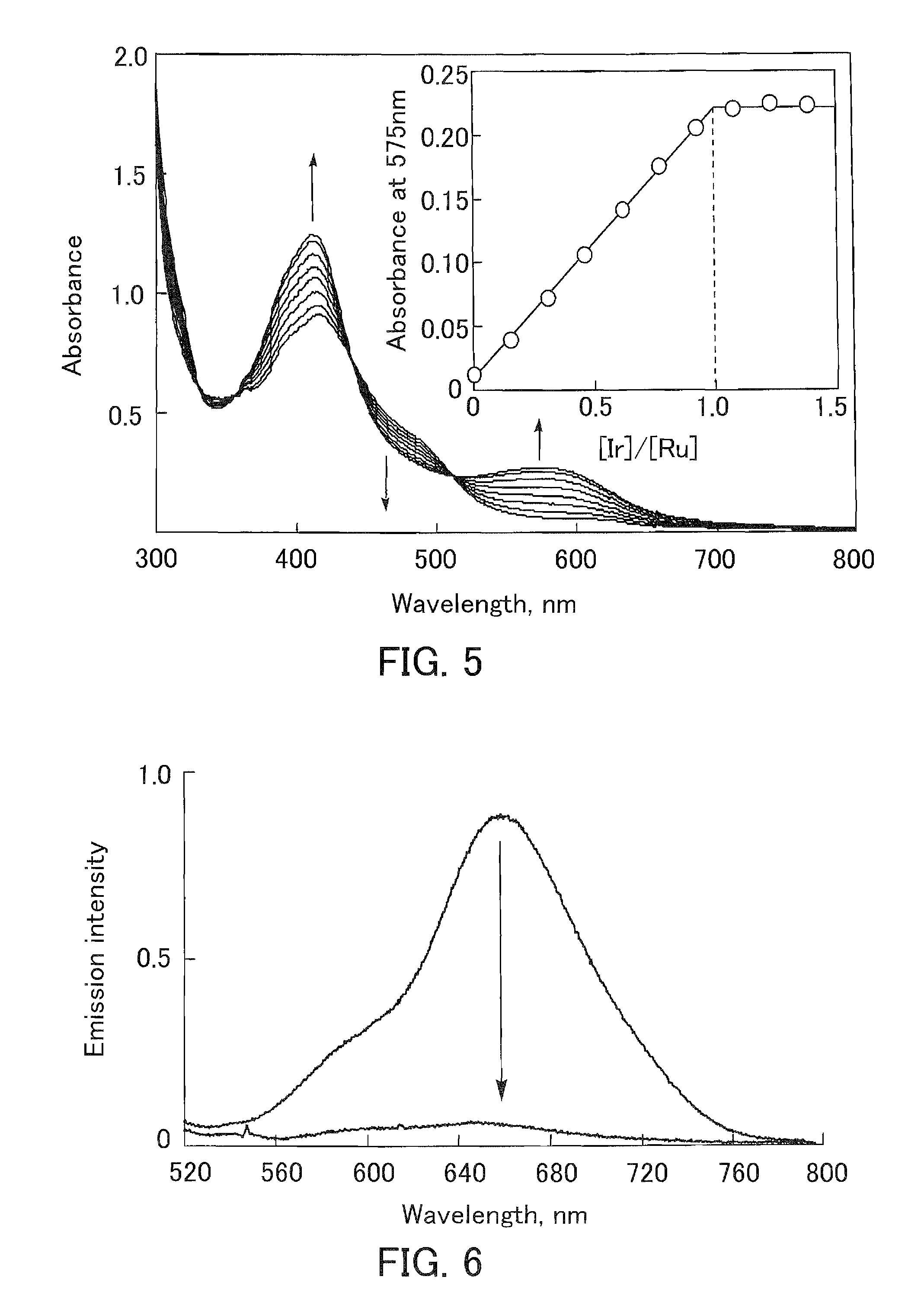Catalyst for decomposition of formic acid, method for decomposing formic acid, process for producing hydrogen, apparatus for producing and decomposing formic acid, and method for storing and generating hydrogen
a technology of formic acid and catalyst, which is applied in the direction of catalyst activation/preparation, liquid gas reaction process, and catalyst activation/preparation, etc., can solve the problems of incomplete oxidized substances such as carbon monoxide and hydrocarbons, the formation of poisoned by-products, and the difficulty of stable supply or storage of hydrogen, etc., to achieve safe and low cost hydrogen (h2), stable and highly safe substances, and high reactivity
- Summary
- Abstract
- Description
- Claims
- Application Information
AI Technical Summary
Benefits of technology
Problems solved by technology
Method used
Image
Examples
production example 1
Complex Production Example 1
Production of a Dinuclear Metal Complex (Aqua Complex)
[0106]An iridium-ruthenium dinuclear aqua complex (8), which is the compound (dinuclear metal complex) according to the present invention, was produced (synthesized) in the following manner. That is, first, a dehydrate (3.1 g, 6 mmol, manufactured by Strem Chemicals, Inc.) of bis(2,2′-bipyridine)dichlororuthenium Ru(bpy)2Cl2, which is a commercially available reagent, was added to water (20 ml) to form an aqueous solution. Ag2SO4 (1.87 g, 6 mmol) was added to the solution, and the solution was then stirred at room temperature for 12 hours. The precipitate AgCl was filtered off with a glass filter (G4), and the filtrate further was filtered through a membrane filter (Advantec, made of PTFE (polytetrafluoroethylene)). The filtrate was dehydrated under reduced pressure to obtain a sulfate (SO42−) salt of [Ru(bpy)2(H2O)2]2+ as an air-stable red solid. The sulfate (0.6 g, 1.1 mmol) of the ruthenium aqua com...
production example 2
Complex Production Example 2
Production of a Dinuclear Metal Complex (Hydride Complex)
[0133]The aqua complex (8) synthesized in Example 1 was reacted with an excess amount of formic acid in water (pH 2.0). Specifically, dilute sulfuric acid was added to 0.4 mL of water to adjust the pH to 2.0, and a sulfate (1.0 mg, 8.8×10−3 mmol) of the aqua complex (8) synthesized in the above-described manner was added and dissolved therein. After the aqueous solution was deoxygenated by bubbling argon gas, formic acid (8.3 mL, 2.2×10−1 mol) was added to the aqueous solution and reacted at 333 K. When the UV-Vis. spectrum of the aqueous solution after the reaction was measured, the spectrum of an iridium hydride complex (9) in which the aqua ligand of the aqua complex (8) was replaced by hydride was observed. Note that the structure of the iridium hydride complex (9) was as represented by the formula (9). Here are the data obtained by instrumental analysis of the iridium hydride complex (9).
[0134]...
production example 3
Complex Production Example 3
Production of a Dinuclear Metal Complex (Iridium Monovalent Complex)
[0137]The aqua complex (8) was reacted with formic acid in the same manner as in Complex Production Example 2 except that the pH of the aqueous solution was set to 4.0 instead of 2.0 by adding sodium hydroxide to the aqueous solution. When the UV-Vis. absorption spectrum of the aqueous solution after the reaction was measured, a spectrum extending into the near infrared region (λ>900 nm) and having several absorption maximums (λmax=453, 512, and 723 nm) was observed. This spectrum can be considered to be derived from an iridium monovalent complex represented by the formula (10). A possible reaction mechanism is, for example, that the aqua complex (8) reacted with one equivalent of formic acid to generate the iridium hydride complex (9), which was then thermally deprotonated to generate the iridium monovalent complex (10). However, this is an example of an inferable mechanism and is not to...
PUM
| Property | Measurement | Unit |
|---|---|---|
| boiling point | aaaaa | aaaaa |
| melting point | aaaaa | aaaaa |
| temperature | aaaaa | aaaaa |
Abstract
Description
Claims
Application Information
 Login to View More
Login to View More - R&D
- Intellectual Property
- Life Sciences
- Materials
- Tech Scout
- Unparalleled Data Quality
- Higher Quality Content
- 60% Fewer Hallucinations
Browse by: Latest US Patents, China's latest patents, Technical Efficacy Thesaurus, Application Domain, Technology Topic, Popular Technical Reports.
© 2025 PatSnap. All rights reserved.Legal|Privacy policy|Modern Slavery Act Transparency Statement|Sitemap|About US| Contact US: help@patsnap.com



